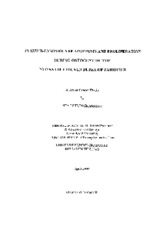| dc.description.abstract | Apoptosis, or programmed cell death, is believed to be the mechanism for depletion of lymphocytes recognizing self antigens following clonal expansion in the bursa of Fabricius. Further, some evidence suggesting that recognition of foreign antigens, presented by the bursal follicular epithelial cells, may promote retention and expansion of selected clones by protection from apoptosis. While bursal apoptosis has previously been shown to increase following in vivo exposure to glucocorticoids, the microanatomical site of induced or normal apoptosis has not been unequivocally established. Presently, we adapted the existing TUNEL (Terminal Deoxynucleotidal Transferase Mediated dUTP Nick End Labeling) assay for use with neonatal bursae. Similar to previous reports, TUNEL revealed that normal apoptosis is preferentially, but not completely, ongoing in bursal follicular cortical cells. Administration of a single dose of either a synthetic glucocorticoid (dexamethasone) or androgen (19-nortestosterone) failed to cause follicular lymphocyte depletion and increased apoptosis per unit of area at the time points evaluated post-administration (6 or 24 hrs). However, administration of either steroid increased the interfollicular epithelial thickness, a change usually associated with edema, within 6 hr following treatment. Additionally, administration of the androgen 19-Nortestosterone significantly decreased the number of proliferating cells as detected using mouse anti-PCNA as a primary immunohistochemical antibody. These findings extend existing data suggesting that normal bursal apoptosis occurs to a greater degree in the bursal follicular cortex although steroid-mediated lymphocyte apoptosis was not observed in these experiments. Unexpectedly, a very low incidence (0.26%) of follicles predominantly containing apoptotic lymphocytes was observed in normal bursal tissues. While the reason for the presence of bursal follicles consisting of predominantly apoptotic cells is not known, possible reasons are intriguing. Future elucidation of the underlying physiological or pathophysiological processes responsible for this phenomenon may lead to important clues for more complete understanding of humoral immune system ontogeny. | en |


